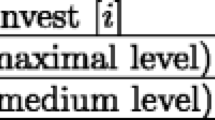Abstract
We argue that an approach that relies solely on the sequential structure of a game would be useful, and provide an alternative proof of the existence of sequential equilibrium.

Similar content being viewed by others
Notes
See paragraph 3 in page 864 in Kreps and Wilson (1982).
See the first paragraph of the concluding remarks in page 885 of Kreps and Wilson (1982).
A game may have multiple roots, in which case a probability distribution on R is specified and interpreted as the distribution of the “states of nature”.
\(B \times M\) is endowed with the relative topology, when viewed as a subset of a (finite-dimensional) Euclidean space, the latter endowed with the standard topology.
This is the behavior strategy profile, associated with the vector of probability distributions \(b^{\epsilon , \star }\), that gives a probability distribution at each of the information sets.
References
Aliprantis, C.D., Border, K.C.: Infinite Dimensional Analysis: A Hitchhikers Guide. Springer, New York (2006)
Aliprantis, C.D., Chakrabarti, S.K.: Games and Decision Making. Oxford University Press, New York (2011)
Fudenberg, D., Tirole, J.: Perfect Bayesian equilibrium and sequential equilibrium. J. Econ. Theory 53, 236–60 (1991)
Kline, J.J., Luckraz, S.: Equivalence between graph-based and sequence-based extensive form games. Econ. Theory Bull. (2016). doi:10.1007/s40505-016-0094-z
Kreps, D.M., Wilson, R.: Sequential equilibria. Econometrica 50, 863–894 (1982)
Kuhn, H.W.: Contributions to the Theory of Games II. Princeton University Press, Princeton (1953)
Osborne, M.J., Rubinstein, A.: An Course Game Theory. MIT Press, Oxford (1994)
Selten, R.: Re-examination of the perfectness concept for the equilibrium points in extensive games. Int. J. Game Theory 4, 24–55 (1975)
Acknowledgments
We thank the Editor, Nicholas Yannelis, and an anonymous referee, whose comments significantly improved the paper. We acknowledge comments from participants at the Midwest Theory Conference, Northwestern University, May 2010 and the Gardner Conference, Indiana University, Bloomington, April 2011, and 13th SAET Conference on Current Trends in Economics, MINES Paris Tech, July 2013. We also acknowledge some very useful conversations with the late C. D. Aliprantis on this topic and would also like to thank Michael Baye, Will Geller, Pavlo Prokopovych, and Eric Rasmussen for some very useful questions and comments.
Author information
Authors and Affiliations
Corresponding author
Rights and permissions
About this article
Cite this article
Chakrabarti, S.K., Topolyan, I. An extensive form-based proof of the existence of sequential equilibrium. Econ Theory Bull 4, 355–365 (2016). https://doi.org/10.1007/s40505-016-0098-8
Received:
Accepted:
Published:
Issue Date:
DOI: https://doi.org/10.1007/s40505-016-0098-8
Keywords
- Sequential equilibrium
- Perfect Bayesian equilibrium
- Sequential games
- Imperfect information
- Backward induction
- Information sets
- Consistent assessment
- Beliefs




